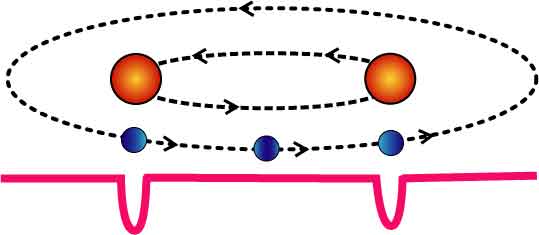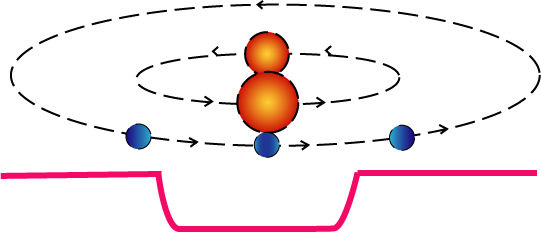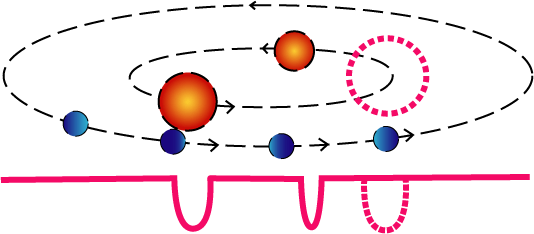
Searching
for Shadows of Other Earths
Cat: SCI
Pub: 2000
#: 0220b
Laurance R. Doyle, Hans-Jorg deeg and Timothy M.
Brown
02531u/18216r
Title
Searching for Shadows of Other Earths
他の地球たちの影の探索
Subtitle
Astronomers have found dozens of giant planets beyond
our solar system, but they haven't been capable of bagging an Earth
- until now.
天文学者は我々の太陽系以外の所に巨大な惑星を幾つも発見した。しかし、今のところまだ地球を捉えることまではできていない。
Author
Laurance R. Doyle, etc.
ローランス R. ドイル他
Published
2000
2000年
Index
Why?
- Recent observational technology, in particular
due to the development of CCD (charge-coupled device) camera, and
advance data processing, the search of possibility of extraterrestrial
life is getting more accurate.
- We are targeting to search promising other
sun-like systems which have planets like ours rather than random search
of every stars.
- Then at last we could catch the shadows of
planets of other sun-like systems.
- Following is an article of Scientific American,
Sept. 2000; I devoured this in the stratosphere on the returning flight
from San Diego to Narita.
- "No one has ever seen a planet outside
our solar system. But in November of last year (1999) two astronomers
saw the next best thing; its shadow.
- David Charbonneau, a graduate student at
Harvard University, and and nearly same time Greg Henry, Tennessee
State University astronomer, were analyzing the brightness of the
sunlike star "HD209458" around the binary stars CM Draconis,
using data taken earlier.
- It is an unassuming star, without even a
proper name. But it has one claim to fame: around it orbits a planet
with a mass at least two thirds that of Jupiter.
- The planet had only been inferred indirectly
by the wobbles it induced in the stara.
- Might it be possible for the planet to pass
in front of the star, across our line of sight, and temporarily block
some of the starlight?"

- Impressed by the most recent discovery, Dr. Alan P. Boss said he
could foresee "the incredible number of other planets we will
be finding as the search techniques are improved."
- 最新の観測技術、特にCCDカメラの進歩、データ処理の高速化により、地球外生命探査の精度が着実に上がりつつある。
- 闇雲に全天を探査するのではなく、惑星系を持つ他の太陽系をターゲットにするのである。
- そしてついに他の星の惑星の影を捉えたのだ。
- 以下はScientific American誌2000年9月号に掲載された記事である。これをSan
Diegoから成田への帰路のジェットで成層圏飛行中にむさぼり読んだ。
- 誰も我々の太陽系外の惑星を見たものはいない。しかし、昨年1999年11月に2人の天文学者が、実物でこそなかったが、その影を見つけた。
- Harvard大学大学院生の David Charbonneau とほとんど同時期にTennessee州立大学の天文学者であるGreg
Henry は、おおいぬ座の連星の周辺にある太陽に似た星"HD209458"の明るさを分析していた。
- それは目立たなくて固有の名前もない星である。しかしすぐ有名になった。その回りに木星の2/3以上の質量をもつ惑星が回っているからである。
- 我々の視線上で、その星の光がゆらぐことによって、間接的に惑星の存在が想定されるのである。
- もし、我々の視野の延長線上で、星の前面をその惑星が通過するとすれば、一時的にその星の明かりが一部遮られ得るだろうか。
- 太陽系外の惑星はその後も次々と発見されている。2002年1月現在、77個の惑星が確認されている。
- 左図のその一部のイメージ図である。
- Two New Planets
By John Nobel Wilford, The New York Times, Mar. 30,
2000)
- The astronomers (Dr. Geoffrey W. Marcy and Dr. R. Paul Butler of
the University of California at Berkeley) did not actually see the
planets. They monitored slight wobbles of the host stars as they responded
to the gravitational pull exerted by the planets' orbits near them.
That motion creates a periodic displacement, or Doppler shift, in
the spectrum of the stars seen from the Earth.
- Note: Jupiter's mass is 317 times that of Earth, Saturn's 95 times.
------------
- Planet-1:
- Orbits a star (HD16141), 117 light-years away, in the constellation
Cetus.
- 70 % of Saturn's mass.
- Orbits its star every 75 days.
- Orbits about 52 million km from the star.
- Its surface is blasted by heat up to 815 degrees Celsius.
- Planet-2:
- Orbits a star (HD46375) 109 light-years away, in the constellation
Monoceros.
- 80% mass of Saturn's mass.
- Orbits its star every 3 days.
- Orbits 6.1 million km from the star.
- Its surface temperature about 1,130 degrees Celsius.
Summary
要約
>Top 1. Now you see it:
- That is the idea behind the transit method for the detection
of planets. Consider a planet in a binary star system. For these
purposes, astronomers do not actually see the two individual stars;
the light is lumped together. As the planet passed in front of each
star from our perspective, the system dims in a characteristic way.
The precise amount and duration of dimming depends on where the
stars are in their mutual orbit.
- Such an event, known as a transit, requires the planetary
orbit to be tilted nearly edge-on, but that is not as improbable
as it might seem. For planets that orbit very close to their stars,
such as the one around HD209458, the chance of the correct alignment
is one in 10.
- As precisely the time the wobble observations indicated that
transits might occur, the star dimmed by about 1.8% for an interval
of three hours. Besides providing clear evidence for a planet,
the dimming directly measured its diameter, 1.3 times that of
Jupiter - the first size measurement ever made of an extrasolar
planet. The size matched theoretical predictions that the planet,
located so close to its star, would have puffed up like a roasted
marshmallow.
- <Fig.1>
Here the stars are at their greatest apparent separation. The planet
makes a double transit; it passes in front of one, then the other.

- <Fig.2>

- If the planet passed in front when one of the stars is eclipsing
the other, the transit can last for longer and produce a larger relative
decrease in brightness.
- <Fig.3>

- If the planet passed in front just prior to a stellar eclipse, a
triple transit occurs; first across the near star, then across the
far one (but for a shorter time because the star and planet are moving
in opposite directions) and finally across the far one again.
1. 今やそれが見える:
- それは惑星探知のための天体面通過法の背後にあるアイデアである。連星系にある惑星を考えてみよう。実際には、天文学者は、二つの星を個別に見てはいない。光は一緒になって見えるのである。我々の方向から見て、惑星がいずれかの星の前面を通り過ぎる時、連星系は明るさを変化にある特徴を見せる。明るさの変化の正確なと期間は、その連星の軌道の互いの位置関係に依る。
- これは天体面通過として知られている現象で、その惑星の軌道面から観測できることが条件となるが、思ったほどにあり得ないことではない。HD209458のように、惑星はそれらの星の非常に近くを周回しており、正しい観測位置にある確立は10分の1である。
- ゆらぎの正確な時間の観測によれば、天体面通過は起こっていると思われ、星は3時間の間隔で約1.8%暗くなる。さらに惑星の存在がますますはっきりしたのは、暗くなることによってその直径が測定でき、それは木星の1.3倍であることがわかった。これは太陽系外の惑星としては初めてのサイズの測定である。その惑星の直性は理論とも合致しており、その太陽の近くにあって、マシュマロが焙られたパフで吹かれたような状態になっている。
- (Fig.1参照)
この図では、連星の2つの星は見かけ上一番離れている。惑星の天体面通過は2回起きる。一回目は一つの星の前を通過する時で、二回目は他の星の前を通過する時である。
- <注>天体面通過(transit)/食現象:
小天体が大天体の面上を通って小円形の食現象をおこす場合にも通過という.
- 変光星(Variable star):
見かけの光度(等級)が時間によって変化する恒星。
- 食変光星/食連星(eclipsing variable):
連星の食現象によって見かけの光度が変化する変光星。代表的な変光星の名をとってアルゴル型変光星 (Algol-type variable)とも呼ばれる。
- (Fig.2参照)
もし惑星が、連星の一つの星が他の星の食現象の時に前を通過すると、天体面通過は長く続き、明るさの減少も相対的に大きくなる。
- (Fig.3参照)
もし惑星が星の食現象に先行して前を通過すると、天体面通過は3回起こる。最初は近くの星の前を通過し、その後は遠くの星の前を通過する(但し、1回目より短い時間となるが、それは星と衛星とが反対方向に動いているからである。)そしてもう一度遠くの星の前を通過するのである。
>Top 2. Transit Method:
- The transit method:
This method had made an auspicious debut. Until now, planet hunters
had relied mainly on the wobble technique, technically known
as the radial-velocity method. That approach looks for subtle
periodic shifts in a star's spectrum, which intimate that the star
is being tugged to and from by an unseen companion.
- Its first success came in 1995 with the discovery of a planet
around the sunlike star 51 Pegasi.
- Since then, more than three down such planets have swum into
astronomers' ken. The radial-velocity method can be applied
to any star, but it has trouble seeing worlds that are too small
or too distant from their stars.
- The transit method has its own serious disadvantage - the
need for a fortuitous orbital alignment. But when transits do
occur, they reveal the planet's size and other properties, even
if it is a fairly small world.
- In fact, the transit method is the only technique currently
able to spot planets down to Earth size around sunlike stars.
2. 天体面通過法:
- 天体面通過法:
この方法は、幸先の良いデビューを飾った。今までに惑星探知は、主に視線速度(天体が観測者に対して前進・後退する速度)測定法として知られる「ゆらぎ」技術を使っていた。それは、見えない伴星により引っ張られることで、恒星の微妙なスペクトラムの周期的な変化となって表れるの。
- 最初の観察の成功は1995年で、ペガスス座の51 Pegasiの太陽のような恒星を回る惑星が発見された。
- それ以来、このような惑星は3つ以上天文学者の観測に捉えられた。視線速度測定法はどの恒星にも適用できるが、惑星があまり小さいあるいは遠い軌道の場合は困難である。
- 天体面通過法は、それ自身の宿命的な欠点がある。それは軌道面が運良くうまく配列されていることが条件となる。しかしもし天体面通過が起こると、たとえ小さくとも惑星のサイズなど詳細をデータを測定できる。
- 事実、天体面通過法は今の所、地球サイズの惑星を特定できる唯一の方法である。
-
>Top Photometry:
- The careful measurement of stellar luminosity is an entire subfield
of astronomy known as photometry.
- The unaided human eye can easily tell when a star changes
in brightness by a factor of about 2.5. By comparing the brightness
of two stars in a procedure known as differential photometry,
the trained eye can discern much subtler changes.
- Small telescope equipped with modern CCD cameras can achieve
a precision of 0.1%. Larger telescopes, by collecting more light
and averaging out atmospheric irregularities, can do even better.
- This signal is proportional to the cross-sectional area of
the planet and hence varies with the ratio of the square of
the planet's radius to the square of the star's radius. In contrast, the wobble in the radial velocity of a star is proportional
to the ratio of the planet's mass to the star's mass and hence
to the ratio of the cubes of their radii. Because planets are
much smaller than stars - Jupiter's radius is about 10% of the
sun's, and Earth's about 1% - the ratio of the squares is more
than the ratio of the cubes, which acts in favor of transit
measurements.
- A Jupiter-size would causes its star to dim by about 1%, well
within the instrumental precision of a one-meter telescope;
an Earth-like world, about 0.01%, which is beyond the capability
of even the largest telescopes currently available.
- The distance between a plant and its star must also be taken
into account. The wobble method falls off in sensitivity as
the square root of this distance, because far-off worlds exert
a weaker gravitational pull on their stars. This very bias is
why most planets found this way have been Jupiter-size bodies
in tight orbits.
- But transit events can be detected as easily for properly
aligned distant companions as for nearby ones. It is a purely
geometric effect the relies on the relative positions of
star, planet and observer.
- Compared with the light-years that separate the star from
Earth, the distance between star and planet is utterly insignificant;
it could change by a large fractional amount, and from our
perspective the amount of dimming would remain almost the
same.
-
光度測定法:
- 恒星の光度の詳細測定は、フォトメトリ(光度測定法)として知れられる天文学の一分野である。
- 人間の裸眼では恒星の明るさは2.5倍変化すれば容易に区別できる(注:等級による光度比)2つの恒星の明るさを比較は、訓練すればもっと微妙な変化を識別できる。
- 最近のCCDカメラを装備した小型望遠鏡を使えば0.1%の精度を識別できる。もっと光を集めてかつ大気変化を除ける大型望遠鏡では、更に精度は上がる。
- この信号は、惑星の断面積に比例するので、惑星の直径の二乗と恒星の直径の二乗の比によって変化する。対照的に、恒星の視線速度のゆらぎは、惑星の質量と恒星の質量の比に比例する、即ち各々の直径の三乗の比に比例する。それゆえ、惑星は恒星よりずっと小さいので(木製の直径は太陽の10%、地球は1%)二乗の比は三乗よりも大きいので、天体面測定法の方が有利に働く。
- 木星サイズの惑星がその恒星に与える光量減少は約1%で、これは1mクラスの天体望遠鏡の精度であり、地球サイズでは、これが約0.01%の光量変化となり、現在の最大級の望遠鏡の能力を超える。
- 惑星と恒星の間の距離も考慮しなければならない。ゆらぎ測定はこの距離の平行根に比例して減少するので、遠方の惑星は恒星に与える重力の影響がそれだけ弱くなる。このことがこの方法で発見されたほとんどの惑星がで近くを周回する木星サイズであった理由である。
- しかし、天体面通過は、遠方の伴星もうまく整列していれば近くの伴星同様に測定できる。それは恒星、惑星、観測者の相対的な位置関係に依る純粋に幾何学的な効果であるからである。
- その恒星と地球との何光年という距離に比べれば、観測する恒星と惑星の距離は問題にならない。つまり、大きな変化量として測定でき、我々の観測される光の減少はほとんど同じである。
>Top 3. Extraterrestrial monitoring:
- Eclipsing binaries are nature's gift to the planet hunter. Theorists
believe that if any planets do form in binary systems, they tend
to form in the same orbital plane as the two stars. If so, the probability
of seeing a transit is 100%. When such a planet passes in front
of its parent stars, it should cause a telltale double dip as it
blocks the light of one star and then the other. The shape of the
double dip would depend on the geometric configuration.
- In 1994 we organized a worldwide network of one-meter-class
telescopes - the TEP (Transit of Extrasolar Planets)
network - to look for Earth-like worlds around CM Draconis,
one of the smallest known eclipsing binary systems. This system
consists of two very small, very cool stars about nine billion
years old, located roughly 54 light-years away. Planets within
its habitable zone would have orbital period ranging from about
18 to 35 days. To do a thorough search of this zone for Earth-like
planets, the TEP network had to observe the system for a total
of more than 1,000 hours.
- This correlation of possible transit models with our observations
is known as "matching filter." Nine possibilities,
all involving a planet of about 2.5 Earth radii across, made
the cut. The test has been to check whether transits continue
to occur on cue. At press date, two possibilities remain - one
with a 21-day orbit and and other with a 26-day orbit.
3. 地球外からの観測:
- 食関係にある連星は、惑星探索にとって自然の恵みである。理論的には、連星系において惑星が存在しているとすれば、それは連星と同じ軌道面を構成している傾向がある。もしそうであれば、天体面通過は100%起こる。衛星がその恒星の前面を通過するとき、まず一つの恒星の光を遮り、次にもう一つというように2回の光の減衰が起こるに違いない。2回の減衰の形は星の位置関係による。
- 1994年に、1mクラスの望遠鏡世界ネットワークであるTEP(Transit of Extrasolar
Planets)を組織した。これは食関係にある小さな連星の一つである竜座の星周辺にある地球クラスの惑星を探索するためである。この連星は非常に小さくて冷たく、誕生から約90億年を経過し、54光年遠方にある星である。生命可住ゾーンに存在する惑星の軌道周期は18日から35日の間である。このゾーンにある地球クラスの惑星を徹底的に探索するために、TEPネットワークは1000時間以上もそのシステムを観察しなければならなかった。
- 我々の観測はこの天体面通過の可能性のあるモデル相関関係を調べるもので、「マッチングフィルタ」として知られている。地球の約2.5倍の半径をもつ惑星を限界とすると9つの可能性が残り、これらはうまく行けば天体面通過が再び起こるかどうか検証することになった。一つは21日で、もう一つは26日の軌道周回である。
- Satellites of the planets:
Eventually, transits could even reveal whether the planets have
satellites. By causing a gentle ripple in the orbital motion of
their parent planets, satellites would slightly alter the transit
timing.
- For example, if extraterrestrial astronomers were monitoring
the sun, they would notice a slight dimming every 365.24 days
and thus deduce the presence of Earth. Over the years, however,
the transits would occur up to two minutes late or early, implying
the presence of a moon (once other orbital effects had been
accounted for). If extraterrestrial' photometry was extremely
precise, they could directly detect a bit of extra dimming caused
by the moon.
- Eclipse-timing method:
- Transits are not the only way a planet might make its presence
known to a photometer. An eclipsing binary is a kind of clock;
stellar eclipses should occur at regular intervals. If the clock
is not keeping perfect time, it may mean that an unseen body is
tugging at the stars.
- If a Jupitor-mass planet pulled the binary star away from us,
say, the eclipses would seem to occur a few seconds late, because
it would take the light from the two stars that much longer to
reach Earth. The farther the planet or the greater its mass, the
greater the offset would be.
- A giant planet can therefore be detected without transiting
the two stars at all. Using existing data, astronomers have already
placed limits on the prevalence of giant planets in certain systems.
- 惑星の衛星:
また天体面通過は惑星が衛星をもっているかを知ることができる。惑星の軌道周回にわずかの波動が生じるのであって、それは衛星が天体面通過のタイミングをわずかに変化させるのである。
- 例えば、もし地球外の天文学者が我々の太陽を観測しているとすれば、彼らは265.24日毎にわずかの光の減少に気づき、これによって地球の存在を導き出すことができる。さらに何年も観測を続ければ、天体面通過は2分間遅れたり早まったりすることで、再び他の物体の周回が説明でき、月の存在が示唆される。もし地球外の光量測定が非常に正確ならば、彼らは月によって生じるほんのわずかな光の減少を直接測定できる。
- 食のタイミング法:
- 天体面通過は、光量測定計によって惑星の存在が知られる唯一の方法ではない。食を起こす連星は一種の時計である。即ち、恒星の食は規則的な間隔で起こる。もしその時計が完全に正確でない場合は、見えない物体がその星を引っ張っていることを意味する可能性がある。
- もし木星質量程度の惑星が連星を我々から離れる方向に引っ張っているとすれば、食は数秒間発生が遅れるように見える。それは連星からの光が地球に到達する距離が長くなるからである。
惑星がさらに遠くにあるか、あるいはの質量が大きさによってその効果がうち消される度合が増える。
- 従って巨大な惑星が連星の天体面通過がなくても探知できる。既存のデータを使って、天文学者は、ある系における巨大惑星の存在限界をすでに求めることができる。
>Top 4. Earth-size planets:
- Reflected light of a planet:
- High photometric precision and years-long observations allow
for yet another spinoff; the reflected light of a planet. Planets
sufficiently close to their stars should reflect a perceptible
amount of starlight. They undergo phase changes similar to those
the moon goes through each month, thus producing a cyclic undulation
that can be distinguished from other variations in stellar brightness.
The technique should pick up bodies with an orbital period of
one week or less.
- It could even probe the nature of the planet itself, because
rough-surfaced planets would cause steeper variations in brightness
than smoother ones would.
- Because the largest sources of error in measuring stellar
light curves come from Earth's atmosphere, watching the stars
from space would clearly improve matters. An orbital observatory
should be able to achieve a phtometric accuracy of 0.002%. Several
such missions are now in the works.
4. 地球サイズの惑星:
- 惑星からの光の反射:
- 恒星の光量測定と何年にも亘る観測によって、予期せず効果が得られた。即ち、惑星から反射された光である。惑星は恒星にかなり近いので、測定可能な程度の恒星の光を反射する。それらは月の毎月の満ち欠けに似た変化を生じ、恒星の光度が、循環する波動変化として捉えられ、恒星の光量変化の他の揺らぎと区別できる。この技術によって1週間かそれ以内の循環的な変化をともなった物体を選び出せる。
- それは惑星自身の性質を突きとめることにもなる。つまり起伏のある表面は滑らかな表面に比べて光量変化は鋭くなるからである。
- 恒星の光量測定におけるエラーは地球大気が最大の原因であり、これは宇宙空間からの恒星の観察によって明らかに改善する。地球の軌道上にある観測設備は、光量測定の精度は0.002%にまでになっている。現在、このような調査ミッションがすでに進行中である。
- The European spacecraft COROT is set to launch in 2004
and will be sensitive to planets as small as twice the size of Earth.
- NASA Kepler satellite. It would monitor 170,000 stars in
the constellation Cygnus and, if the statistical trends hold, should
detect the transits of more than 600 terrestial-size planets, as
well as the reflections of an additional 1,700 or so giant inner
planets.
- These world would be obvious targets for space-borne nulling
interferometers, which should eventually be able to cancel the
stellar glare and take actual picture of the planets.
- During the transits, the planets will be backlit by their
stars, which could make it easier to examine them spectroscopically
for potential markers of life, such as ozone, water and methane.
- Age of first discovery:
All of us in the field feel privileged to live in an age of first
discovery.
- Renaissance astronomer Chirstiaan Huygens wrote:
"What a wonderful and amazing Scheme have we here of the
magnificent Vastness of the Universe! So many Suns, so many
Earths!" Was Huygens correct? Are there other planets like
ours? are they inhabited? By the end of the decade, we should
know.
- 欧州の宇宙船COROTが、2004年に打ち上げ予定されており、地球サイズの2倍までの大きさの惑星探査に優れている。
- NASAのKepler衛星。これははくちょう座近辺の170,000の恒星を探索し、もし統計のよる傾向の通りとすれば、600以上の地球ザイズの惑星の天体面通過、さらに1,700個程度の巨大な内惑星からの反射を探査する。
- これらの惑星は、宇宙空間の浮かぶ零位電波干渉計のあきらかな目標となっている。これらは結果として恒星のまぶしい光をキャンセルし惑星の真のピクチャを取ることができる。
- 天体面通過の間は惑星は、恒星によって背後から照らされ、生命の兆候となるオゾン、水、メタンなどの分光測定が腰囲に行われ得る。
- 注)
radio interferometer(電波干渉計):
離れて設置されたアンテナで受けた天体からの電波を干渉させ、電波源の広がりなどを高分解能で測定する装置
- 第一発見の時代:
この分野の我々は、第一発見の時代に生きている特権を味合うことができる。
- ルネッサンス期の天文学者クリスチアン・ホイゲンス曰く、「宇宙空間の壮大な広がりはなんとすばらしく驚嘆すべき情景であろうか。多くの太陽があり、そして多くの地球があるのだ」と。ホイゲンスは正しかったのだろうか。我々と同じような惑星が他にあるのだろうか。そこは住めるような場所なのだろうか。あと十年もすれば我々はその回答を手にする。
>Top 5. Pros and Cons of various methods:
- PROS AND CONS of various methods ofr planet finding are summarized
on this chart, which shows the medhods' sensitivity to planets of
a given mass (vertical axis) and a given distance from their parent
star (horizontal axis).
- Even at its theoretical limit, the radial-velocity method (back line) misses sub-Saturn worlds unless they are very close
in.
- The transit method can spot Earth-size bodies (yellow)
- The eclipse-timing method (blue) picks up distant planets
more readily than nearby ones.
5. 各探査法の比較:
- <下図参照>
下図は衛星探査の各種方法の長所短所を示す。
縦軸は衛星の質量(左縦軸は木星質量比、右縦軸は地球質量比)、 横軸は恒星からの距離(天文単位)
(1天文単位(AU)=太陽/地球間距離=約1.5億km)
- 理論的限界においても、視線速度法(黒線)では土星より小さい惑星は、恒星に非常に近い場合を除いて使えない。
- 天体面通過法(黄色)は、地球サイズの惑星にも有効。
- 食タイミング法(青色)は近くの惑星のみならず遠方の惑星探査にも有効。

Comment
- As of Jan. 2002, it is surprising that 77 possible extraterrestrial
planets have been reported; which convinces us "we are NOT ALONE"
in this universe.
- Also, it is sure to say that these discoveries are largely depending
on the recent advancement of computer and telecommunication technologites.
We are having larger and more sensitive eyes and ears to find and
listen to the possibility of other extraterrestial lifes.
- 2002年1月の時点で、地球外の惑星の可能性は77個も発見されていると報道は驚きである。そのことは、この宇宙の中で「我々は孤独ではない」ということに確信を持てるようになってきている。
- さらに、これらの発見は最近のコンピュータとテレコム技術の進歩に大きく依存していることは間違いない。我々は地球外生命の可能性を見つけだし、聴きだすために一層感度の良い目と耳を持ちつつあるのだ。
 |
Searching for Shadows of Other Earths |
Cat: SCI
|
Laurance R. Doyle, Hans-Jorg deeg and Timothy M. Brown |
02531u/18216r |
Title |
Searching for Shadows of Other Earths |
他の地球たちの影の探索 |
|---|---|---|
Subtitle |
Astronomers have found dozens of giant planets beyond our solar system, but they haven't been capable of bagging an Earth - until now. | 天文学者は我々の太陽系以外の所に巨大な惑星を幾つも発見した。しかし、今のところまだ地球を捉えることまではできていない。 |
Author |
Laurance R. Doyle, etc. |
ローランス R. ドイル他 |
Published |
2000 |
2000年 |
|
||
Why? |
|
|
Summary |
要約 |
>Top 1. Now you see it:
|
1. 今やそれが見える:
|
>Top 2. Transit Method:
|
2. 天体面通過法:
|
|
|
>Top 3. Extraterrestrial monitoring:
|
3. 地球外からの観測:
|
|
|
>Top 4. Earth-size planets:
|
4. 地球サイズの惑星:
|
|
|
>Top 5. Pros and Cons of various methods:
|
5. 各探査法の比較:
|
 |
|
Comment |
|
|
|---|